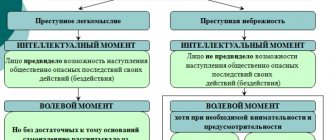This concept means an organized group that was formed for the purpose of committing crimes, or an integral union of two or more previously formed organized groups of criminals. A criminal association is the most dangerous form of criminal complicity. The creation of such a community, according to Russian criminal law, is an independent crime. Responsibility is provided even in cases where the created community has not yet committed a single crime. In the Russian Criminal Code, punishment for this act is provided for in Art. 210. Such a community is the highest form of organized crime.
Important!
Community is the most dangerous form of complicity when there is prior agreement. The increased social danger of this type of complicity is manifested not only in the number of crimes, but also in their severity. Sociological research and statistics of court cases indicate that today such communities are formed for the purposes of drug trafficking and attacks on property.
Signs of a criminal community
- A sign of such an association is its structure, which implies a clear hierarchy in the structure of the community. This hierarchy, in turn, implies its division into separate groups with their own functions, a special procedure for selecting new members of the community and determining the responsibility of the latter, the receipt and use of special technical means by the community, the use of methods of conspiracy and protection from law enforcement officers, the creation and implementation of legalization schemes with the purpose of covering up illegal activities, the presence of strict discipline, preventing anyone from leaving the community with a set of measures to implement this ban, the structural relationship of the community to other associations.
- Another sign of a community is stable, planned, clandestine activities using shadow economic schemes and a combination of legal and illegal areas of economic activity, establishing influence in a certain territory, neutralizing crime-fighting agencies through corruption of the latter.
- The next sign is the increased cohesion of such associations, the coordination of the actions of participants. This is the difference between a criminal community and other forms of complicity, including prior approval. A community is a stable, cohesive group of people who have united to conduct jointly illegal activities, including crimes of grave and especially grave degrees, or the unification of previously formed criminal groups for similar purposes. The cohesion of participants is an attribute only of a criminal community as a form of complicity.
The stability of a community consists of constantly existing connections between participants and special ways of performing actions. Stability implies that there is prior agreement between members and organization. Cohesion is a social and psychological feature of a community, reflecting the community of members when they implement criminal goals. Community members share roles among themselves when they achieve illegal intentions.
Resilience and cohesion are predictive factors in the persistence of criminal activity and the significant severity of crimes committed by community members. Taking into account the danger of the activity for the purpose of which such communities are created, the legislation of the Russian Federation qualifies the very creation of a criminal community, its management, as well as participation in it as an independent crime.
Commentary on Article 210 of the Criminal Code of the Russian Federation
1. On the concept of a criminal community, see the commentary to Art. 35 of the Criminal Code.
2. The characteristics of a criminal community (criminal organization) are organization, structure and a special purpose of activity - committing serious or especially serious crimes to obtain directly or indirectly financial or other material benefits.
3. Structurality characterizes the structure, internal structure of a community (the presence of hierarchically organized groups, divisions; their possible “specialization” or implementation of special functions, for example: planning the commission of crimes and countermeasures to solve them; ensuring interaction between various structural parts of the community (organization); maintaining connections with corrupt law enforcement officials, other state and municipal authorities).
Its structural unit is understood as a functionally and (or) territorially isolated group consisting of two or more persons (including the leader of this group), which, within the framework and in accordance with the goals of the criminal community, carries out criminal activities. Such structural units, united to solve the general tasks of a criminal organization, can not only commit individual crimes (bribes, forge documents, etc.), but also perform other tasks aimed at ensuring the functioning of the community (clause 4 of the Resolution of the Plenum of the Supreme Court RF dated June 10, 2010 N 12 “On judicial practice in considering criminal cases involving the organization of a criminal community (criminal organization) or participation in it (it)” <1>).
——————————— <1> BVS of the Russian Federation. 2010. N 8.
4. On creation and leadership as signs of a crime, see the commentary to Art. 208 of the Criminal Code.
5. Coordination of criminal actions, the creation of stable connections between various independently operating organized groups presupposes the establishment of strong interdependent, interdependent relationships between various organized groups, for example: committing joint crimes, defending common interests at a meeting of representatives of organized groups, using members of other groups “at showdowns” , the creation of a single “common fund”.
6. The division of spheres of criminal influence and criminal proceeds between organized groups is the determination of the “territorial boundaries” of the action of a criminal group, specific objects at which the latter can commit crimes; distribution of income as a result of committing a crime, etc.
7. Responsibility for participation in a meeting of organizers, managers (leaders) or other representatives of organized groups (so-called gatherings of criminal authorities) may be borne by three groups of persons:
1) organizers;
2) managers (leaders);
3) other representatives of organized groups who do not occupy a higher position in the criminal hierarchy.
8. The crime is considered completed from the moment the act is committed in any of the listed forms.
9. The subjective side of the crime is characterized by direct intent and the purpose of committing grave and especially grave crimes in order to obtain directly or indirectly financial or other material benefits.
10. The subject of the crime is a sane person who has reached the age of 16 years.
11. On participation in a community as a sign of a crime, see the commentary to Art. 208 of the Criminal Code.
12. The actions of a member of a criminal community who is not the perpetrator of a specific crime, but in accordance with the distribution of roles within this community performing the functions of an organizer, instigator or accomplice, are subject to qualification under the relevant article of the Criminal Code, regardless of his actual role in the crime committed without reference to Part. Parts 3, 4 and 5 art. 33, as well as under Part 2 of Art. 210 CC.
13. If participants in a structural unit that is part of a criminal community, along with participation in such a community, created a stable armed group (gang) for the purpose of attacking citizens or organizations, and also led such a group (gang), what they did is subject to qualification if there is a real totality of crimes committed under Art. Art. 209 and 210 of the Criminal Code, as well as under the relevant articles of the Special Part of the Criminal Code for a specific crime committed.
14. The use of official position is understood not only as the deliberate use by a person of his official powers, but also by exerting influence, based on the significance and authority of the position held, on a person subordinate to him, in order for him to commit certain actions aimed at creating a criminal community (criminal organization) and/or participation in it.
15. Special subject of a crime - an official, a civil servant and an employee of local self-government bodies who are not classified as officials, as well as a person who permanently, temporarily or by special authority performs organizational, administrative or administrative duties in a commercial organization, regardless of form property or in a non-profit organization that is not a state or municipal institution (Part 3 of Article 210).
16. Committing a crime under Part 1 of Art. 210, a person occupying a higher position in the criminal hierarchy entails liability under Part 4 of the commented article.
17. In the note to Art. 210 provides for conditions under which a person is completely exempt from criminal liability.
Quantitative composition
The laws of different countries have different views on the number of united offenders, which can be called a criminal society.
For example, in the Criminal Code of Italy , “famous” as the birthplace of the mafia, the minimum number of people included in such an association is three people. In Chinese law there are also three people.
But not all legislation has a quantitative criterion that defines a criminal community; for example, according to the laws of the Russian Federation, it may well include only two people.
But in most cases, in long-standing PSs the number of members is much larger .
Article 210. Organization of a criminal community (criminal organization) or participation in it (it)
Commentary on Article 210
1. The peculiarity of this crime is that criminal liability is established for the very fact of organizing a criminal community (criminal organization) or participating in it, regardless of whether any crimes have been committed. In Post. The Plenum of the Armed Forces of the Russian Federation dated June 10, 2010 N 12 provides an interpretation of the concept of a criminal community, its characteristics, as well as the characteristics of all elements of this crime. 2. The objective side of the act in question is expressed: a) in the creation of a criminal community (criminal organization) for the purpose of jointly committing one or more grave or especially grave crimes (Part 1 of the commentary article); b) management of such a community (organization) or its structural divisions (part 1); c) coordination of criminal actions (Part 1 of the commentary article); d) creating stable connections between various independently operating organized groups or dividing spheres of criminal influence and criminal proceeds between them (Part 1); e) participation in a meeting of organizers, managers (leaders) or other representatives of organized groups (Part 1); f) participation in a criminal community (criminal organization) (Part 2 of the commentary article). 3. In part 4 of Art. 35 of the Criminal Code determines that a crime is recognized as committed by a criminal community (criminal organization) if it is committed by a structured organized group or association of organized groups operating under a single leadership, whose members are united for the purpose of jointly committing one or more grave or especially grave crimes in order to obtain direct or indirectly financial or other material benefit. A criminal community (criminal organization) differs from other types of criminal groups, including an organized group, by a more complex internal structure, the presence of the goal of jointly committing grave or especially grave crimes in order to obtain directly or indirectly financial or other material benefits, as well as the possibility of combining two or more organized groups for the same purpose. Direct receipt of financial or other material benefit is understood as the commission of one or more grave or especially grave crimes, as a result of which the direct illegal circulation of funds and other property is carried out in favor of members of a criminal community (criminal organization). Indirect receipt of financial or other material benefit is understood as the commission of one or more grave or especially grave crimes that do not directly encroach on someone else’s property, but which, however, determine the subsequent receipt of funds and rights to property or other property benefits not only by members of the community (organization), but also by other persons (clause 2 of the Post. Plenum of the Armed Forces of the Russian Federation dated June 10, 2010 No. 12). A criminal community (criminal organization) can carry out its criminal activities in the form of a structured organized group or an association of organized groups operating under a single leadership. A structured organized group as a group of persons who have united in advance to commit one or more serious or especially serious crimes, consisting of units (subgroups, units, etc.) characterized by stability of composition and coordination of their actions. In addition to a single leadership, such a group is characterized by the interaction of its various divisions in order to implement common criminal intentions, the distribution of functions among them, the presence of possible specialization in the performance of specific actions when committing a crime, and other forms of ensuring activity. In paragraphs “a” and “c” of Art. 2 of the Convention against Transnational Organized Crime of 11/15/2000 states that “organized criminal group” means a structured group of three or more persons, existing for a certain period of time and acting in concert to commit one or more crimes, and “structured group" means a group that was not accidentally formed for the immediate commission of a crime <1>. ——————————— <1> See: SZ RF. 2004. N 40. Art. 3882.
A structural unit of a criminal community (criminal organization) as a functionally and (or) territorially isolated group consisting of two or more persons (including the leader of this group), which, within the framework and in accordance with the goals of the criminal community (criminal organization), carries out criminal activities . Such structural units, united to solve the common problems of a criminal community (criminal organization), can not only commit individual crimes, but also perform other tasks aimed at ensuring their functioning. The association of organized groups presupposes the presence of a single leadership and stable ties between independently operating organized groups, joint planning and participation in the commission of one or more serious or especially serious crimes, and the joint performance of other actions related to the functioning of such an association. 4. The characteristic features of a criminal community (criminal organization) are organization, structure and the special purpose of jointly committing grave or especially grave crimes in order to obtain directly or indirectly financial or other material benefits. Organization presupposes a clear distribution of functions between accomplices, careful planning of criminal activities, provision of criminal activities with instruments and means of committing a crime, community security, establishing connections with corrupt officials, the presence of internal strict discipline, a common material and financial base, etc. For example, in the case of S., E. and D., the verdict in terms of conviction under Part 2 of Art. 210 of the Criminal Code, E. under Part 1 of Art. 210 of the Criminal Code, and the case was dismissed due to the lack of corpus delicti in their actions, since such circumstances were not established <1>. ——————————— <1> BVS of the Russian Federation. 2001. N 9. P. 9.
A sign of the structuring of a criminal community (criminal organization) characterizes its (her) structure, internal structure, including the presence of a leadership team, hierarchy of organized groups, divisions, criminal specialization, established rules for the relationship and behavior of participants in a criminal community, discipline, etc. For example, in the case of Kh., K., S., B., G., it was recognized that a criminal community was created for the purpose of stealing citizens’ funds through fraud. The convicts were engaged in a “scam” with the aim of committing theft of funds through fraudulent means. In each group, called a “brigade,” there was a clear distribution of roles, defining places of “work,” developing new “points,” collecting money, attracting citizens to participate, subordination to the group leader, and daily determination of the start and end times of criminal activity. The units of the criminal community were associations of 10 or more individuals under a single leadership with a clear distribution of roles between participants and strict internal discipline. One or several organized groups operated simultaneously or alternately, and the stolen funds of citizens were accumulated by the leaders of criminal groups <1>. ——————————— <1> BVS of the Russian Federation. 2003. N 6. P. 9.
A sign of a criminal community (criminal organization) is the presence of the crime specified in Part 1 of Art. 210 of the Criminal Code for a special purpose - the joint commission of one or more grave and especially grave crimes. Although the sign of cohesion of a criminal community (criminal organization) is not directly indicated in the law, their criminal activity is determined by the joint commission of crimes. Cohesion should be understood as the presence of common goals and intentions among members of the organization that transform the criminal community into a single whole. Criminal liability for the creation of a criminal community (criminal organization) or for participation in it (it) occurs in cases where the leaders (organizers) and participants of this community (organization) are united by intent to commit grave and (or) especially grave crimes when they are aware of common the purposes of the functioning of such a community (organization) and their belonging to it (it). 5. The elements of the crime under consideration are formal . The creation of a criminal community (criminal organization) for the purpose of jointly committing one or more grave or especially grave crimes is considered completed from the moment of their actual formation, the creation of structural units within an organized group or the unification of organized groups and the commission of actions indicating the readiness of the criminal community (criminal organization) ) realize their criminal intentions regardless of whether the planned crimes are committed. This can be expressed, for example, in obtaining the consent of members of a community, organization, association of organizers, leaders for joint unified criminal activity, for subordination to the leader of previously created and existing organized groups, for planning to commit serious or especially serious crimes, for concluding conditions for the division of territories , zones of influence, industries, the scale of criminal activity, its financing, preservation of the subculture, measures of punishment and encouragement, legalization of criminal proceeds, counteraction to law enforcement agencies, establishment of qualified legal assistance, criminal connections with government officials, bribery, other actions necessary for carrying out criminal activities and etc. 6. Regarding the leadership of a criminal community (criminal organization) or its structural divisions, the act should be recognized as completed from the moment the person’s consent to perform the relevant leadership functions is received. leadership of a criminal community (criminal organization) or its structural units should be understood as the exercise of organizational and (or) management functions in relation to the criminal community (criminal organization), its structural units, as well as its individual units. participants both when committing specific crimes and when ensuring the activities of a criminal community (criminal organization). Such leadership can be expressed, in particular, in defining goals, in developing general plans of activity, in preparing to commit specific serious or especially serious crimes, in performing other actions aimed at achieving set goals: for example, in the distribution of roles between members of the community, in organizing logistics, in developing methods for committing and concealing crimes, in taking security measures, secrecy, in distributing funds received from criminal activities, in legalizing (laundering) funds obtained by criminal means, in recruiting new participants, introducing members of a criminal community (criminal organization) to government agencies. Management of a criminal community (criminal organization) can be carried out either individually by the head of a criminal community (criminal organization), or by two or more persons united for joint leadership (for example, the head of a criminal community (criminal organization), the head of a structural unit, a manager (leader) organized group). 7. Coordination of criminal actions should be understood as their coordination between several organized groups included in a criminal community (criminal organization) for the purpose of jointly committing planned crimes. The creation of stable connections between various independently operating organized groups should be understood, for example, as the actions of a person to unite such groups in order to carry out joint actions to plan, commit one or more serious or especially serious crimes. Responsibility for the coordination of criminal actions, the creation of stable connections, the development of plans and the creation of conditions for the commission of crimes or the division of spheres of criminal influence and criminal proceeds, committed by a person using his influence on members of organized groups, begins from the moment of actual establishment of contacts and interaction for the purpose of committing these criminal actions. Criminal liability of a person who took part in a meeting of organizers, managers (leaders) or other representatives of organized groups occurs in cases where at such a meeting issues related to planning or organizing the commission of acts specified in the disposition of part 1 comment were jointly discussed. articles. 8. The person who created the criminal community (criminal organization), his (her) leader, as well as persons exercising collective management of such a community (organization), bear criminal liability under Part 1 of the comment. article for the commission of at least one of the criminal acts specified in it, as well as under the relevant articles of the Criminal Code for all crimes committed by other participants in the criminal community (criminal organization) and in the case where they did not directly participate in the commission of specific crimes, but they were covered by their intent . Additional qualifications for the actions of the organizer or leader of a criminal community under Part 2 of the comment. no article required. 9. Participation in a criminal community (criminal organization) is considered completed from the moment of commission of at least one of the specified crimes or other specific actions to ensure the activities of the criminal community (criminal organization). Participation in a criminal community (criminal organization) as inclusion in a community (organization), as well as the development of plans to prepare for the commission of one or more serious or especially serious crimes and (or) the direct commission of these crimes or the performance by a person of functional duties to ensure activities of such a community, for example. financing, supplying information, maintaining documentation, creating conditions for committing crimes, etc. Persons who are not members of a criminal community (criminal organization), when providing one-time assistance to their activities, are responsible for complicity in the form of aiding and abetting , as well as for actions that constitute an independent crime. 10. Criminal liability of a participant in a criminal community (criminal organization) occurs regardless of his awareness of the actions of other participants and the circumstances of planned and committed crimes. In cases where a member of a criminal community (criminal organization) commits a crime that was not covered by the intent of other participants, when the crime was not committed in connection with the plans of the criminal community (criminal organization), his actions are considered as an excess of the perpetrator . In the absence of an agreement with other participants in a criminal community (criminal organization), actions committed by a participant in this community (organization) that were aimed at ensuring the functional activities of the community (organization) are subject to qualification under the relevant article and art. 210 CC. If participants in a criminal community (criminal organization), along with participation in the community (organization), created a stable armed group (gang) or led it, then what they did forms a real set of crimes and is subject to qualification under Art. Art. 209 and 210 of the Criminal Code, and if there are grounds for this, also for participation in another specific crime. 11. The subjective side of the crime is characterized by direct intent . A mandatory feature is a special purpose - the joint commission of one or more grave or especially grave crimes. 12. The subject of the crime is a sane individual who has reached the age of 16. Persons aged 14 to 16 years who have committed specific crimes together with members of a criminal community (criminal organization) are subject to criminal liability only for those crimes for which liability is provided for in Art. 20 of the Criminal Code from the age of 14. 13. Part 3 comment. The article provides for a qualified crime - the commission of acts provided for in Parts 1 and 2 of the comment. articles, by a person using his official position . The subject of the crime is special . The use of one’s official position should be understood as actions similar to those provided for in Art. 209 of the Criminal Code. This is not only the deliberate use by a person of his official powers, but also exerting influence, based on the significance and authority of the position he holds, on a person under his subordination, for him to commit certain actions aimed at creating a criminal community (criminal organization) or participating in him (her). Persons who have committed such acts should include both officials and civil servants and employees of local self-government bodies who are not classified as officials, as well as persons who permanently, temporarily or by special authority perform organizational, administrative or administrative duties. in a commercial organization, regardless of the form of ownership, or in a non-profit organization that is not a state or municipal institution. 14. Part 4 comments. The article also provides for a qualified crime - the acts provided for in Part 1 of the comment. articles committed by a person occupying a higher position in the criminal hierarchy . When deciding on such a subject, it is necessary to establish the position occupied by this person in the criminal hierarchy, what exactly were the actions of such a person in creating or leading a criminal community (criminal organization) or in coordinating criminal actions, creating stable connections between various independently operating organized groups or division of spheres of criminal influence and criminal proceeds, as well as other criminal actions indicating his authority and leadership in the criminal community (criminal organization). The leadership of such a person in the criminal hierarchy may also be evidenced by the presence of connections with extremist and (or) terrorist organizations or the presence of corruption ties, etc. 15. In note. to comment The article provides for three conditions for the complete release of a person from criminal liability : 1) voluntary termination of participation in a criminal community (criminal organization) or a structural unit included in it, or a meeting of organizers, managers (leaders) or other representatives of organized groups; 2) actively contributing to the detection or suppression of this crime; 3) the absence of any other crime in his actions. Voluntariness presupposes that a person ceases to participate in a criminal community (criminal organization) of his own free will, regardless of motives, in the absence of forced circumstances, and if he has an objective opportunity to continue his participation. For example, a person realized his mistake and the mistake of participating in the corresponding criminal group, the futility of further participation, repented, began to fear for his fate or for the fate of family members, close people, etc. Active facilitation involves such actions of a person as surrendering, reporting to law enforcement agencies certain information about the criminal community (criminal organization), its leaders, crimes committed, money and property obtained by criminal means, instruments and means of crime, etc., which can be committed both while a person is a member of a criminal group, in particular, with the aim of stopping its activities, and after actually leaving it. If there is another element of crime in the actions of the guilty person, criminal liability for this crime is not excluded. 16. It should be noted that the Criminal Code does not stipulate in any of the elements of crime the commission of a crime by a criminal community (criminal organization) as a qualifying or specially qualifying feature. However, if a criminal community (criminal organization) commits a crime where an organized group is indicated as a qualifying or specially qualifying characteristic, then such a crime is qualified according to this characteristic, since a criminal community (criminal organization) is one of the types of organized group. If the elements of the crime committed do not include as a qualifying characteristic the commission of it by an organized group, then the actions of the person are subject to qualification according to the qualifying characteristic of “a group of persons by prior conspiracy”, and in its absence - according to the characteristic of “a group of persons”. For example, in the case of B., Z., S., Ch., K. and others, it was recognized that the actions of persons participating in a criminal community for the purpose of stealing oil products from an oil pipeline and committing thefts were reasonably qualified under Part 2 of Art. 210 and according to paragraphs “a”, “b”, part 3 of Art. 158 Criminal Code <1>. ——————————— <1> BVS of the Russian Federation. 2003. N 9. P. 10.
Punishment for organizing a criminal community
In Part 1 of Art. 210 of the Criminal Code of the Russian Federation provides for punishment for the creation and management of a criminal community. Leadership also involves managing one or more divisions of a given community, creating an association of organizers and other representatives of organized groups. The purpose of the above actions is to develop conditions and plans for the commission of particularly serious and serious crimes. Coordination, development of criminal activity and support are also the goals of organizing a criminal community.
Punishment under Part 1 of Art. 210 of the Criminal Code of the Russian Federation - imprisonment for a term of 7-15 years. In addition to imprisonment, Article 210 of the Criminal Code of the Russian Federation provides for the possibility of imposing a fine of up to 1 million rubles. Also, a fine can be imposed in the amount of the income or wages of the guilty person for a period of up to 5 years.
Participation in the association of leaders, organizers, and other representatives of organized groups in the criminal community in accordance with Part 2 of Art. 210 of the Criminal Code of the Russian Federation is punishable by imprisonment for a term of 3 to 10 years. A fine is also provided for. The fine is up to 500 thousand rubles or in the amount of the income (wages) of the guilty person for a period of up to 3 years.
Punishment for acts described in parts 1 and 2 of Art. 210 of the Criminal Code of the Russian Federation, committed by a person using his official position - imprisonment for a term of 10 to 20 years. In addition, a fine of up to 1 million rubles or in the amount of the income (wages) of the offender for a period of up to 5 years may be imposed.
If a person who was part of a criminal community voluntarily ceased his participation in it and provided active assistance to the investigation in order to suppress or solve a crime, he is exempt from criminal liability. An important point in such a situation is the absence of another corpus delicti in the actions of this person. Active assistance to the investigation consists of either providing information about the criminal community by a person who has ceased to participate in it, or by a person arriving as part of the community.
Age limit for a crime classified under Art. 210 of the Criminal Code of the Russian Federation – 16 years. Part 3 art. 210 of the Criminal Code of the Russian Federation provides for an age limit of 18 years. This is due to the specifics of work in certain positions.
The organizer of a criminal community or its leader are liable under Art. 210 of the Criminal Code of the Russian Federation. The remaining participants are liable under Art. 210 and for the crimes in which they participated. From the moment a criminal organization is created, the crime is considered completed. The moment of creation may consist in reaching an agreement on the division of spheres of influence, in obtaining the consent of community members for joint criminal activities, and in the presence of evidence of the development of plans to commit crimes.
Signs of PS
Signs of a criminal community:
- One of the main features of a PS is the cohesion of its members. There is a strong connection between them, based on a similar worldview and chosen ways of achieving goals. This connection guarantees the stability of the hierarchy within the team, which does not collapse under the influence of random incidents.
- Participants in society recognize themselves as a society that has its own common goals , in which everyone should participate.
- The presence of resources and various material means that are intended to commit criminal acts and conceal them.
- Each member knows and is aware of the responsibilities that are clearly assigned to him.
- Direction to commit a certain type of illegal act.
- Distribution over a large area .
Often criminal societies operate in the territories of several states. - Criminals can carry out their actions in the most sophisticated ways to avoid prosecution and ensure maximum benefit for themselves.







